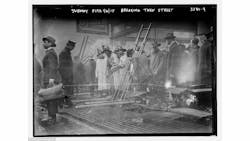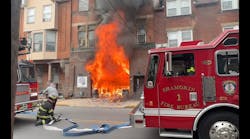NEW YORK CITY: JAN. 4, 1915 – An early-morning fire broke out in the cellar of the Hotel Albert at University Place and Eleventh Street. One of the guests, wearing pajamas, played “Tipperary” on the hotel’s piano to help the 100 or so guests stay calm as they exited the smoke-filled building. The first-arriving engine pushed a line into the smoke-chocked cellar, only to have their officer knocked unconscious. He was pulled to safety as the battle continued.
FRANKLIN, NJ: JAN. 15, 1915 – A fire believed to have been caused by defective electrical insulation started in the early morning in the Franklin House hotel. A dozen guests, asleep at the time, hurried to escape. One man was severely burned while attempting to return for some of his belongings. Fireman Robert Collins was seriously injured when a wall collapsed.
TRENTON, NJ: JAN. 18, 1915 – While 300 people were at work, someone sneaked into the John A. Roebling’s Sons Co. plant, cut the wires to the fire alarm system and set a series of rubbish fires that ignited a major blaze. Within hours, eight acres of factories and a block of workers’ homes were ablaze. The Roeblings, renowned structural steel and wire manufacturers, and builders of the Brooklyn Bridge, had suffered previous arson fires at their plant. This blaze was battled for three hours with only one injury. Fire Chief James Bennett injured his leg when knocked down by a horse. Many believed the fire to have been started by German saboteurs trying to stop the flow of supplies to the war in Europe.
BEVERLY, NJ: JAN. 24, 1915 – A possible arson fire destroyed the newly acquired building on Cooper Street that housed the Masonic Lodge. The frame building burned fiercely and mutual aid was summoned from nearby departments. Firemen battled the cold and dealt with ice-covered streets and equipment. One fire engine responding from Burlington City could not get up the grade out of the railroad tunnel. A team of horses was used to pull the rig up. The structure was a total loss. All that remained was a fireproof safe. Important lodge documents inside the safe, however, were damaged by the extreme heat and were later replaced.
NAHCOTTA, WA: JAN. 27, 1915 – A fire that began in an abandoned hotel was fanned by strong winds and wiped out the business section of town. The flames jumped the street and railroad tracks, igniting hotels, stores, the post office, train depot, train sheds and roundhouse. Despite the best efforts of the volunteer fire department, the flames could not be halted.
CAPTION:
NEW YORK CITY, JAN. 6, 1915 – Two alarms were transmitted for an extremely smoky fire in the subway on Broadway at 55th Street. Hundreds of people were overcome by the smoke and had to be rescued. Unconscious people were dragged from the subway and lined sidewalks. Special calls for extra firemen without apparatus were sent out. First-aid stations were set up in the street and firemen, police and doctors worked to revive the numerous victims. All 25 of the fire department’s “pulmotors” (a type of resuscitator) were sent for along with those from nearby hospitals and even from the Safety Museum. A wave of unconscious firemen then began, as they too suffered from the debilitating effects of the smoke produced by burning insulation. In all, 200 people were taken to hospitals and one person died. This fire prompted the FDNY into enacting a plan it had been working on for some time. Twelve days later, the department orders announced the formation of Rescue Company 1. Eight firemen and two officers began a program of intense training to help overcome some of the difficulties encountered at these serious fires. The photos show firemen breaking through the street to access the subway and firemen recovering after being overcome. Photos from Paul Hashagen Collection
PAUL HASHAGEN, a Firehouse® contributing editor, is a retired FDNY firefighter who was assigned to Rescue 1 in Manhattan. He is also an ex-chief of the Freeport, NY, Fire Department. Hashagen is the author of FDNY: The Bravest, An Illustrated History 1865-2002, the official history of the New York City Fire Department, and other fire service books.
Connect with Paul
Website: paulhashagen.com
Facebook: Paul Hashagen-author






